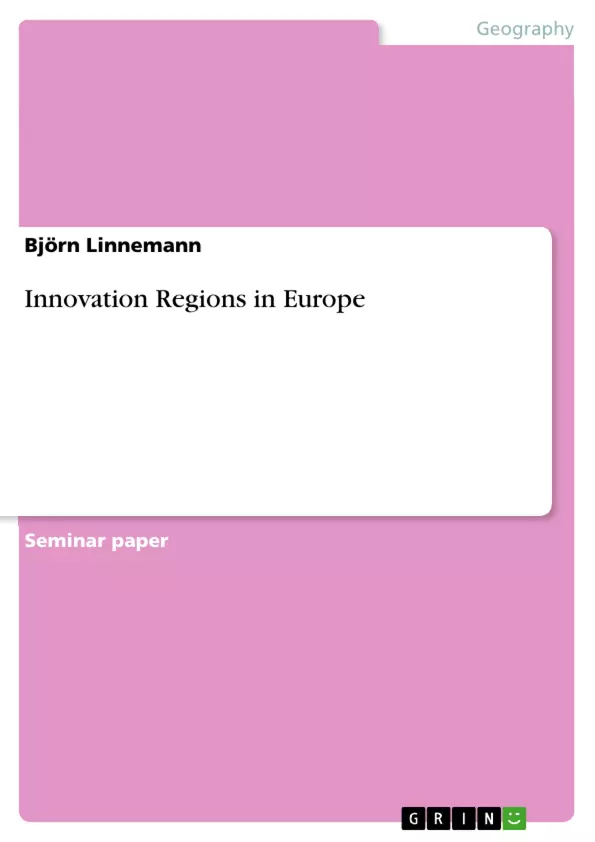Ever since Schumpeter’s work on the business cycles, innovation is widely claimed to be a central aspect of economic development. With market expansion reaching its limits and mass production being relocated into low cost countries, the role of innovation gained more and more importance in order to maintain growth in western industrial countries. In contrast to the industrial processes, innovation is not a process, which can be standardised or routinised. It does not follow mathematically ascertainable schemes, but is rather a dynamic process, which is formed by several factors interacting and enforcing each other (Cooke and Morgan, 1998). The aim of this paper is to shed light on empirically determined factors that promote innovation in certain regions. Eventually some remarkable examples of innovative regions in Europe will underline and verify their importance.
Inhaltsverzeichnis (Table of Contents)
- Introduction
- Spatial aspects of innovation - Why innovations occur in clusters
- Sharing of tacit knowledge
- The role of metropolitan regions
- Services and intermediaries
- Systematic innovation and insitutional underpinnings
- European high-tech regions as empirical evidence
- The Cambridge Phenomenon
- Munich - Leading high tech region in Germany
- Baden Württemberg – A successful region facing challenges
- Tampere - From resource-based to knowledge-based economy
- Grenoble-France's Leading edge technology center
- Conclusion
Zielsetzung und Themenschwerpunkte (Objectives and Key Themes)
This paper aims to identify empirically determined factors that promote innovation in specific regions. The focus is on examining the significance of metropolitan regions as drivers of innovation, highlighting the role of tacit knowledge and the clustering effect in fostering innovation.
- The importance of innovation in economic development
- The role of tacit knowledge in driving innovation
- The clustering effect of innovation in metropolitan regions
- The relationship between knowledge spillovers and geographical proximity
- The characteristics and challenges of high-tech regions in Europe
Zusammenfassung der Kapitel (Chapter Summaries)
- Introduction: The paper introduces the central role of innovation in economic development, particularly for Western industrial countries seeking sustained growth amidst globalization. Innovation is presented as a complex and dynamic process influenced by various interacting factors.
- Spatial aspects of innovation - Why innovations occur in clusters: This chapter explores the significance of tacit knowledge and its local nature, contrasting it with readily accessible codified knowledge. The chapter emphasizes the importance of face-to-face interaction and the role of metropolitan regions in facilitating knowledge sharing and the concentration of skilled individuals.
- European high-tech regions as empirical evidence: This chapter analyzes the success of various high-tech regions in Europe, showcasing their unique characteristics and the challenges they face. The case studies include Cambridge, Munich, Baden-Württemberg, Tampere, and Grenoble, highlighting the diverse approaches to fostering innovation in each region.
Schlüsselwörter (Keywords)
This paper focuses on the concepts of innovation, tacit knowledge, metropolitan regions, knowledge spillovers, and European high-tech regions. It explores the factors driving innovation in specific regions and analyzes successful case studies of innovative clusters in Europe.
- Citation du texte
- M Sc Geography Björn Linnemann (Auteur), 2010, Innovation Regions in Europe, Munich, GRIN Verlag, https://www.grin.com/document/198589



